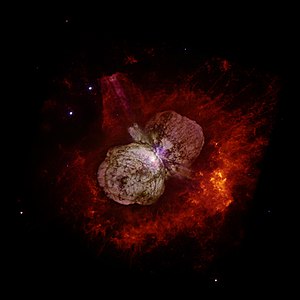Commons:Featured picture candidates/Image:EtaCarinae.jpg
Jump to navigation
Jump to search
Image:EtaCarinae.jpg - not featured
[edit] Info created by Jon Morse (University of Colorado) and NASA Hubble Space Telescope image, published by STScI - uploaded by Yann - nominated by MichaelMaggs -- MichaelMaggs 05:56, 29 April 2008 (UTC)
Info created by Jon Morse (University of Colorado) and NASA Hubble Space Telescope image, published by STScI - uploaded by Yann - nominated by MichaelMaggs -- MichaelMaggs 05:56, 29 April 2008 (UTC) Support -- MichaelMaggs 05:56, 29 April 2008 (UTC)
Support -- MichaelMaggs 05:56, 29 April 2008 (UTC) Support Wow and value -- Slaunger 06:11, 29 April 2008 (UTC)
Support Wow and value -- Slaunger 06:11, 29 April 2008 (UTC) Support impressive --Herrick 07:57, 29 April 2008 (UTC)
Support impressive --Herrick 07:57, 29 April 2008 (UTC) Support dito --Taraxacum 14:04, 29 April 2008 (UTC)
Support dito --Taraxacum 14:04, 29 April 2008 (UTC) Support hermosa Comu nacho 16:09, 29 April 2008 (UTC)
Support hermosa Comu nacho 16:09, 29 April 2008 (UTC) Oppose I know this represents work and the result looks really good, but I can't see what the interest of such edits is : this image is of no big scientific value. Just compare to the NASA original... Sorry. Fred waldron 17:58, 29 April 2008 (UTC)
Oppose I know this represents work and the result looks really good, but I can't see what the interest of such edits is : this image is of no big scientific value. Just compare to the NASA original... Sorry. Fred waldron 17:58, 29 April 2008 (UTC) Oppose As Fred waldron. --Karelj 18:55, 29 April 2008 (UTC)
Oppose As Fred waldron. --Karelj 18:55, 29 April 2008 (UTC) Oppose Per Fred waldron. Lycaon 20:49, 29 April 2008 (UTC)
Oppose Per Fred waldron. Lycaon 20:49, 29 April 2008 (UTC) Oppose Too dark and unclear what this actually is Gordo 16:02, 30 April 2008 (UTC)
Oppose Too dark and unclear what this actually is Gordo 16:02, 30 April 2008 (UTC) Support I feel better knowing that not only mine images, but amazing NASA images also get opposed.--Mbz1 18:44, 30 April 2008 (UTC)
Support I feel better knowing that not only mine images, but amazing NASA images also get opposed.--Mbz1 18:44, 30 April 2008 (UTC)
- Depending on how you define color, all of these space photographs are subjective versions of the object. If you define color as what a human eye would see looking through an eyepiece attached to Hubble (and that would have been really awesome, btw!) you would see this object as mostly white with the darker regions going towards green. Back in the days of images on film, the colors of the astrophotography depended greatly on the brand of film that was being used, for instance. One of the major brands captured more blue than its rival which grabbed the reds. I have no idea what to expect from digital image grabs -- is it dependent on the brand of camera or on the brand of the cf card? I was and still somewhat unclear with the explanation for this human eye phenomena; the explanation was that the eye sees more green -- the color that is inbetween the color of the sun and the color of the sky and the predominate color on the planet (I think). Then, ten or twelve years after that, I learned that the moon is not larger on the horizon due to refractive things with the atmosphere as I had thought and taught, but instead due to a psychological thing that the brain does when it makes object that are on the horizon bigger than objects that are more towards the zenith. Our bodies are sad excuses for measuring tools, it is somewhat impressive that our toys work at all. -- carol 23:04, 30 April 2008 (UTC)
 Support FRZ 01:53, 1 May 2008 (UTC)
Support FRZ 01:53, 1 May 2008 (UTC) Oppose --Urban 04:36, 1 May 2008 (UTC)
Oppose --Urban 04:36, 1 May 2008 (UTC)
 Comment please state reason for opposition as a courtesy to the author/uploader. Lycaon 06:32, 3 May 2008 (UTC)
Comment please state reason for opposition as a courtesy to the author/uploader. Lycaon 06:32, 3 May 2008 (UTC)
 Question/
Question/ Comment
Comment
- I have done a little research on the subject and I am now quite sure this picture is a mix between Image:Eta Carinae.jpg and Image:Etacarinae-001.jpg. I would like to have confirmation on that.
- That leads me to a first question : what is the purpose and scientific interest of such an edit, when each of the two pictures is useful in itself, and shows different things.
- Then, I think the author of that edition should at least be mentioned (it seems to come from the University of São Paulo [1]) ? Can we still consider that it is a NASA image, hence in the public domain ? Vol de nuit 15:15, 1 May 2008 (UTC)
7 support, 5 oppose >> not featured -- Alvesgaspar 10:01, 8 May 2008 (UTC)
